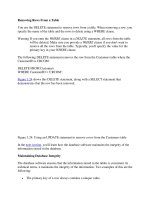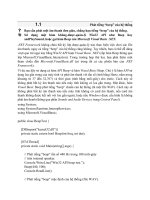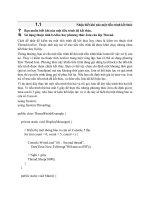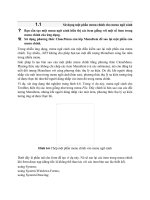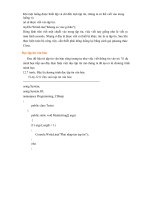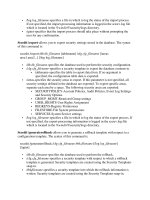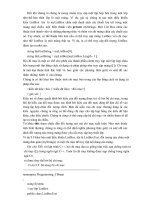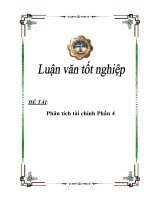Jossey-Bass Teacher - Math Wise Phần 4 doc
Bạn đang xem bản rút gọn của tài liệu. Xem và tải ngay bản đầy đủ của tài liệu tại đây (700.19 KB, 45 trang )
Copyright © 2010 by John Wiley & Sons, Inc.
Dot Paper for 1,000 and More
Dot Paper Diagrams 117
Copyright © 2010 by John Wiley & Sons, Inc.
10,000 Dots
118 Computation Connections
Chapter 32
File Folder Activities
Grades K–6
Ⅺ Total group activity
Ⅺ
× Cooperative activity
Ⅺ
× Independent activity
Ⅺ Concrete/manipulative activity
Ⅺ Visual/pictorial activity
Ⅺ
× Abstract activity
Why Do It:
This activity gives students practice with basic facts, com-
putation, and problem solving by matching. It encourages
students to work as individuals or in small groups and to
self-check their answers. It can also be used as an alternate
way for the teacher to test the students.
You Will Need:
Students will need manila file folders (amount will vary
depending on what you feel needs reviewing), glue, library
pocket envelopes (pockets made out of construction paper or
4- by 6-inch index cards will also work), 3- by 5-inch index
cards, and marking pens.
HowToDoIt:
1. This activity involves the use of file folders, pockets,
and cards to help students review basic mathematical
concepts or to test their knowledge in basic mathemat-
ical facts.
Glue the library pockets inside the file folders. The
number of pockets depends on what is needed for
the review or test. For example, if students need to
review their multiplication facts, then their folder could
119
look like the one pictured in Example 1. Use the marking pens
to write problems on the pockets and their answers on individual
index cards. Prior to starting, hide an answer key to all the pockets
in the Answer Cards pocket.
2. To begin, each student (or pair of students) must take all the
individual answer cards and place them in the matching problem
pockets. If students need to make pencil-and-paper computations
for a given problem, they should use a small piece of scratch paper
and place it in the same pocket as the answer card. Solutions
should be checked against the answer key or by another player
(sometimes with a calculator). If you choose to use the file folder
as a test of a student’s knowledge, then the activity could be timed,
with you checking the solutions.
Examples:
1. Using the file folder below,
a student must match mul-
tiplication facts with the
corresponding answers.
2. This file folder requires stu-
dents to practice telling time
from a clock face. Students
match digital times to those
on ‘‘regular’’ clock faces.
Multiply
6 × 5
7 × 3 8 × 6 9 × 5
4 × 9
36
30 40
7 × 7 8 × 7
56
7 × 6 5 × 5 8 × 4
9 × 95 × 8
6 × 9
8 × 8
6 × 5
Answer
Cards
Time
Answer
Cards
5:15 6:00
9:00
3:00
Extensions:
1. Devise file folders for any area in which practice is needed. The
players, after seeing how the folders are constructed, should make
a variety of folders for one another. These file folders can be made
for matching numerals with pictured amounts; practicing basic
facts; exploring fractions, decimals, measurement, and geometric
identification; working with the concepts of time and money; and
solving short story problems, among other things.
120 Computation Connections
2. Older students can construct and use these file folders to provide
special help for younger learners. Especially useful are folders
dealing with numerals, number sense, place value, and basic math
facts. The folders could also be at a math station in the classroom,
and as students finish their regular work, they could go to the
station to practice certain skills.
3. To increase the difficulty level for this activity and promote careful
thinking, include more than a single correct answer card for certain
problems (for example, a pocket reading ‘‘Find two numbers whose
product is 36’’ might be answered with 4 × 9and6×6) or include
a few wrong answers that do not correspond to any of the folder
problems. One or both of these tactics can be used to turn this
activity into a math quiz.
File Folder Activities 121
Chapter 33
Beat the Calculator
Grades 1–6
Ⅺ
× Total group activity
Ⅺ
× Cooperative activity
Ⅺ Independent activity
Ⅺ Concrete/manipulative activity
Ⅺ
× Visual/pictorial activity
Ⅺ
× Abstract procedure
Why Do It:
Students will practice basic facts and mental math. This
activity will help students become more proficient in recalling
basic mathematical facts, and with this ability they will have
fewer problems with more complicated mathematics.
You Will Need:
At least one calculator is required. If Beat the Calculator is to
be a large group or whole class activity, the teacher can use a
calculator placed on an overhead projection device, or even
a virtual calculator found online. For small groups of two to
five participants, only one calculator is necessary.
How To Do It:
1. In a small group, with one calculator and three people,
the following procedure works well: Student 1 calls out
a math problem, such as 6 ×7. Student 2 uses a calcu-
lator to solve the problem and state the answer. At the
same time, Student 3 solves it mentally and says the
answer. The first to give the correct answer (Student 2
or Student 3) wins. The players’ roles should eventu-
ally be rotated. To make the activity more competitive,
have students tally the number of wins for each student.
122
(Note: Students will soon discover that if they have practiced their
basic facts, they will be able to ‘‘beat the calculator’’ nearly every
time.)
2. Beat the Calculator may also be played as a whole class activity. In
this case, you or a leader operates the calculator, while students
simultaneously do the mental math and call out answers; a chosen
judge calls out the problems and determines the winner of each
round. The object of the activity is therefore to determine which
method is faster and more efficient for obtaining the solutions to
basic fact problems: using a calculator or just memorizing the fact.
Example:
In the small group situation above, Sean had called out 5 × 9. Susan has
been attempting to solve the problem with a calculator before Randy
could do so mentally. However, because Randy had mastered his 5s
multiplication facts, he was able to beat the calculator.
Extensions:
1. Young students might try counting with a calculator by entering a
number (try 1), an operation (try +), and pressing the equal button
multiple times (====) to make the calculator count by 1s.
They can also start with any number, like 20, and enter 20 + 1 =
===. They might further try counting forward (addition) or
backward (subtraction) by any multiple; for example, they can
Beat the Calculator 123
enter 3 +3 ====and see what happens. (Note: Learners should
use a calculator that has an automatic constant feature built in;
most basic calculators do. To test this, simply try the calculator; if
it ‘‘counts’’ as noted above, it has the needed constant.)
2. Students might use a calculator that has an automatic constant
to individually practice basic multiplication facts. For example, to
practice the 4s facts, they can enter 4 ×=, which the calculator
holds in its memory. Then any number entered will be multiplied
by 4 when the = key is pressed. Thus the student might enter 8,
mentally think what the answer should be, press =, and see that
the answer displayed is 32.
3. Advanced students can work in pairs, taking turns trying to beat
the calculator with such tasks as 2 ×12 ÷8 +3 −5 =
or
7 + 32 ÷ 4 − 5 × 2 =
.(Note: In these cases, be certain that the
players use the proper order of operations. The mnemonic ‘‘Please
Excuse My Dear Aunt Sally’’ sometimes helps students remember
the order: parentheses, exponents, multiply or divide from left to
right, and add or subtract from left to right. Students are frequently
unclear about this concept, so even if the calculator has a built-in
order of operations feature, the students should be taught to put
parentheses as shown here: 7 +(32 ÷4) −(5 ×2). The answers to
the two problems in this Extension are 1 and 5, respectively.
124 Computation Connections
Chapter 34
Floor Number Line
Actions
Grades K–6
Ⅺ Total group activity
Ⅺ
× Cooperative activity
Ⅺ Independent activity
Ⅺ
× Concrete/manipulative activity
Ⅺ
× Visual/pictorial activity
Ⅺ
× Abstract procedure
Why Do It:
Students will physically act out computation and mathemati-
cal problem-solving situations.
You Will Need:
This activity requires a walk-on number line, which can be
constructed using soft chalk, tape, and number cards, or a
large roll of paper with a marking pen.
HowToDoIt:
1. To construct the number line, write large numerals
about 1 foot apart either on the playground or floor
using soft chalk, or on a large roll of paper using a mark-
ing pen. If the number line will be used more than once,
itcanbemadebytapingnumbercardstotheflooror
using some more permanent method on the playground
surface. Problems at the beginning will likely make use
of the numerals 0 through 10, but as the work becomes
more difficult, the number line can be expanded to 100
125
or more. If signed numbers are to be used, it should also be
extended from 0 to −1, −2, −3, and so on.
2. Students will solve math problems using this walk-on number
line. The examples below show how to begin. Once students
understand the procedure, have them try some of the problems
in the Extensions section or other problems created by you or
the students. Students should be ready both to explain how they
‘‘walked out’’ each problem and to use pencils and paper to show
the same solution.
Examples:
1. For 4 + 3, students begin at 0 and
take 4 steps to the number 4. Then
they take 3 more forward steps and
check the number on which they
are now standing; it should be 7.
(See the solid arrow in the illus-
tration below.) Finally, students
should keep a record by writing
4 +3 = 7 in their notebooks.
2. For such a problem as 9 ÷4, stu-
dents begin at the 9 and move
toward the 0, taking 4 steps at a
time and holding up a finger for
each time. Beginning at the 9, they
step to 8, 7, 6, and 5 and hold
up 1 finger; then they step to 4,
3, 2, and 1 and hold up 2 fin-
gers. They have therefore taken
4 steps 2 times, but still need to
get to 0; this will require 1 more
step. Thus 9 ÷4requires2setsof
4 steps with 1 step remaining, so
9 ÷ 4 = 2, with a remainder of 1.
126 Computation Connections
Extensions:
Have students use the floor number line to help solve either the following
problems or others that students need to solve from a workbook or text.
Students can also make up several of their own problems and have their
classmates use the number line to figure out the solutions.
1. 8 +3 2. 7 −4 3. 4 ×6
4. 20 ÷5 *5. −2 +−4 *6. −3 + 4
*(Hint: Face in the direction of the first signed number, and then
change direction every time the sign of the number changes.)
Floor Number Line Actions 127
Chapter 35
Egg Carton Math
Grades K–6
Ⅺ
× Total group activity
Ⅺ
× Cooperative activity
Ⅺ
× Independent activity
Ⅺ
× Concrete/manipulative
activity
Ⅺ
× Visual/pictorial activity
Ⅺ
× Abstract procedure
Why Do It:
Egg Carton Math provides students with a fun way to gen-
erate problems and practice computation, and helps them
gain a better understanding of factors of a number, prime
factorization, and probability.
You Will Need:
A 12-cell or 18-cell egg carton with its lid still attached is
required for every student or pair of students. Also required
are paint and brushes, card stock, glue or tape, sticky dots
for labeling, crayons or markers, pencils, beans (larger beans
preferably, such as pinto or lima beans), and photocopies of
the ‘‘Egg Carton Probability’’ handouts (provided).
How To Do It:
There are many things you can do with an egg carton; here
are a few activities designed for various levels of math ability.
1. In order to learn about probabilities, students will be
shaking an egg carton with a bean inside. The cells of
the egg carton will be painted different colors, and the
probability of the bean landing on a certain color is
discussed.
128
Begin with the students painting the egg carton cells with three
different colors in random order. Either tell students how many
cells will be painted red, how many green, and how many blue, or
let them decide for themselves. The colors might also be chosen
randomly by tossing a die: if 1 or 4 appears, students paint the
cell red; if 2 or 5 comes up, they paint the cell green; and if 3 or 6
is rolled, they paint the cell blue. With this method, it is possible
that students will never paint a cell red, which simply means that
the probability of getting a red is zero. Students then need to cut a
piece of card stock the size of the top of the egg carton and glue
it to the top to block the holes through which beans might slip.
They then place one bean inside the egg carton and close the lid.
Students will use the ‘‘Egg Carton Probability’’ activity sheet to
perform the probability experiment. After recording their results,
students can also draw a bar graph on the back of their activity
sheets. Younger students can fill in sections of the blank bar graph
included at the end of this activity.
2. Another way to use the egg carton is to write the numbers 1
through 12 or 1 through 18 (depending on the size of the egg
carton) on sticky dots, and put the dots in each cell such that the
numbers show. Students can use two beans, three beans, or more
depending on their math ability level. After the student shakes the
egg carton, he or she opens it and writes down the numbers on
which the beans have fallen. If two beans land in the same cell,
the student is to write down that number twice. At this point, the
student can add or multiply the numbers together. It works best
if the students are in pairs, so that they can check each other’s
answers. If there are just two beans in the egg carton, the activity
can help students review basic addition and multiplication facts.
For example, one student, after shaking the egg carton, could open
it to find the beans have landed on 5 and 6. The student would
then ask his or her partner to find the sum of 5 and 6. Students can
also keep track of how many correct answers each player comes
upwithin10or20shakes.
3. The third activity is for more advanced students and helps enhance
students’ understanding of prime numbers (counting numbers
with exactly two different factors), composite numbers (counting
numbers with more than two different factors), and prime fac-
torization. Students begin by writing the first twelve or eighteen
prime numbers on the sticky dots (2, 3, 5, 7, 11, 13, 17, 19, 23,
29, 31, 37, 41, 43, 47, 53, 59, and 61). Then they place the dots
in individual cells of the egg carton. Students can use two or
more beans, shake the egg carton, and use the prime numbers
onwhichthebeansfallasprimefactorsofacompositenumber.
Students can then find the composite number by multiplying the
Egg Carton Math 129
prime numbers together. They can also practice using exponential
notation. For example, a student’s five beans could land on 2, 2,
7, 5, and 13. The prime factorization is written 2 × 2 ×5 × 7 × 13
or 2
2
×5 ×7 ×13 which is equal to the composite number 1,820.
Once students have the prime factorization of a number, they
can find all the factors of that number. For example, using the
prime factorization of the number 36 (which is 2
2
×3
2
), a table as
shown below can be set up to find all the factors of 36. Because
the exponent of 2 is 2, 0 through 2 will be used for the exponents
of 2. Similarly, because the exponent of 3 is 2, the exponents of 3
will range from 0 to 2. Also remind students that any number with
an exponent of 0 is equal to 1. To fill out each square in the chart,
students will fill in the power of 2 using the exponent in the
same row at the left and the power of 3 using the exponent in
the same column at the top.
Exponents of 3
0 1 2
Exponents of 2
0 2
0
·3
0
= 1 2
0
·3
1
= 3 2
0
·3
2
= 9
1 2
1
·3
0
= 2 2
1
·3
1
= 6 2
1
·3
2
= 18
2 2
2
·3
0
= 4 2
2
·3
1
= 12 2
2
·3
2
= 36
Therefore, the factors of 36 are 1, 2, 3, 4, 6, 9, 12, 18, and 36.
Extensions:
1. Whenever a game requires a random number generator, the egg
carton with numbers in it can be used, such as when doing the
Sticky Gooey Cereal Probability simulation with 12 prizes instead
of 6 (see p. 214).
2. Place fractions in the cells and have students practice adding or
multiplying fractions. Also, students can discuss the fractional part
of the whole that the colors red, green, or blue represent. If each
student’s egg carton is different, students will be able to see the
many fractions that develop from coloring an egg carton. To extend
this idea further, students could make a list of all the fractions that
are possible when egg cartons are colored in different ways.
3. For advanced students, put positive and negative numbers on the
sticky dots in the egg carton and have them add, subtract, and
multiply the signed numbers. Algebraic expressions can also be
placed in the cells of the egg carton, such as −5x,2x
2
,8x,and
−4x
2
, and students can be asked to add, subtract, multiply, or
divide the expressions.
130 Computation Connections
Copyright © 2010 by John Wiley & Sons, Inc.
Egg Carton Probability
Hypothesis:
Open the egg carton and look at
the colors inside. If you closed
the egg carton with the bean in-
side and gave the carton some
shakes, on which color do you
think the bean would land?
If you were to do this experiment
many times, on which color do
you think the bean would land
the most?
Why do you think this?
Experiment:
Shake the egg carton with the bean in it. Now open the egg carton and
look at what color the bean has landed on. Record the color in the chart
below using an X. Do this 20 times, recording your results each time.
Red
Blue
Green
Conclusion:
1. Which color or colors did the bean land on the most, according to
your experiment?
2. Did you guess right, when you stated your hypothesis above?
Yes or No
3. Draw a bar graph to record your results.
Egg Carton Math 131
Copyright © 2010 by John Wiley & Sons, Inc.
Bar Graph for Egg Carton Probability
RED BLUE GREEN
132 Computation Connections
Chapter 36
Cross-Line
Multiplication
Grades 2–6
Ⅺ
× Total group activity
Ⅺ
× Cooperative activity
Ⅺ
× Independent activity
Ⅺ Concrete/manipulative activity
Ⅺ
× Visual/pictorial activity
Ⅺ
× Abstract procedure
Why Do It:
This activity will visually enhance students’ multiplication
understandings.
You Will Need:
Students will need pencils and paper.
HowToDoIt:
This activity requires that students use a pencil to draw
crossing lines that correspond to factors (numbers) in any
given multiplication problem. If a student wants to solve
3 ×7, he or she will draw three parallel horizontal lines and
seven parallel vertical lines crossing the horizontal lines. Then
they will count the number of intersections (line crossings)
to find the answer to that specific problem. In this case, the
number of intersections is 21 and that is the answer to 3 × 7.
See the figure for clarification.
133
Example:
To solve the problem 6 ×2, the student will need to
show 6 groups of 2. After drawing 6 horizontal lines
and crossing them with 2 vertical lines, the student
will then count 12 crossings, which is the answer to
the problem.
(shows 6 × 2 = 12)
Also, by turning the drawing sideways, the problem
2 × 6 or 2 groups of 6 can also be shown. Thus, 2 ×
6 = 12.
(shows 2 × 6 = 12)
134 Computation Connections
Extensions:
Students could solve the sample problems below.
1. Draw crossing lines to show 3 ×5. There are
line crossings.
So, 3 × 5 =
.
2. Show 4 × 5. 4 ×5 =
.
3. Draw lines for 7 ×5. How many line crossings are there? So,
7 ×5 =
.
4. Choose a multiplication problem. Draw line crossings for it. Your
problem is:
× = .
5. Figure out some more cross-line problems and share them with
the class.
6. Try cross-line multiplication for two-digit multiplication.
2 3
x
3
6 3
12
12
18
24
9
x6
2
183
Add 1 from the 18 to the 2 in 12.
All middle line crossings
Add 2 from the
24 to the 2 in the 12.
9441
Cross-Line Multiplication 135
Chapter 37
Highlighting
Multiplication
Grades 2–6
Ⅺ
× Total group activity
Ⅺ
× Cooperative activity
Ⅺ
× Independent activity
Ⅺ Concrete/manipulative activity
Ⅺ
× Visual/pictorial activity
Ⅺ
× Abstract procedure
Why Do It:
Each student will practice multiplication facts using a visual
procedure and will gain a better conceptual understanding of
these facts.
You Will Need:
A supply of multiplication charts (reproducibles are provided)
and highlighter pens or colored pencils are required.
How To Do It:
This activity will allow a student to find the answer to a
multiplication problem by shading a fact chart. Have students
use a multiplication chart and highlighter pens or colored
pencils to shade areas that show the answers to multiplication
facts. On a separate piece of paper, students then write the
problems and answers that the highlighted areas show.
136
Example:
This chart shows 3 ×5(as3groupsof5)= 15. Or, viewed from the
side, the chart depicts 5 × 3(as5groupsof3)= 15.
10
10
8
8
9
9
7
7
6
6
5
5
4
4
3
3
2
2
1
1
10897654321
2016 181412108642
3024 2721181512963
4032 36282420161284
5040 453530252015105
6048 544236302418126
7056 634942352821147
8064 725648403224168
9072 816354453627189
10080
907060
5040302010
×
Extensions:
Have students complete the following sample problems.
1. Shade in the area for 2 ×3. How many spaces did you highlight?
Thus 2 × 3 =
. Explain how you have also shown the area for
3 ×2.
2. Highlight 3 × 5. Thus 3 × 5 =
and 5 ×3 = .
3. Show 5 × 8. Thus 5 × 8 =
and 8 ×5 = .
4. When you highlight 9 ×3or3×9, the area equals
.
5. 7 ×9or9×7 =
. What do you notice, on the multiplication
chart, about the location of the answer number?
6. Complete a series of highlighted charts and post them next to
one another on a bulletin board. For example, do the 7s facts by
highlighting 7 ×1 on the first chart, 7 × 2 on the second, 7 × 3on
the third, and so on.
Highlighting Multiplication 137
Copyright © 2010 by John Wiley & Sons, Inc.
Multiplication Charts
10
10
8
8
9
9
7
7
6
6
5
5
4
4
3
3
2
2
1
1×
10
10
8
8
9
9
7
7
6
6
5
5
4
4
3
3
2
2
1
1
10897654321
2016 181412108642
3024 2721181512963
4032 36282420161284
5040 453530252015105
6048 544236302418126
7056 634942352821147
8064 725648403224168
9072 816354453627189
10080
907060
5040302010
×
10
10
8
8
9
9
7
7
6
6
5
5
4
4
3
3
2
2
1
1×
10
10
8
8
9
9
7
7
6
6
5
5
4
4
3
3
2
2
1
1
10897654321
2016 181412108642
3024 2721181512963
4032 36282420161284
5040 453530252015105
6048 544236302418126
7056 634942352821147
8064 725648403224168
9072 816354453627189
10080
907060
5040302010
×
138 Computation Connections
Chapter 38
Chalkboard or
Tabletop Spinner
Games
Grades 2–8
Ⅺ
× Total group activity
Ⅺ
× Cooperative activity
Ⅺ Independent activity
Ⅺ Concrete/manipulative activity
Ⅺ Visual/pictorial activity
Ⅺ
× Abstract procedure
Why Do It:
Students will be able to practice with most number and
operation concepts, all within an activity using a spinner to
generate problems.
You Will Need:
This activity requires
a large spinner, made
from a piece of heavy
poster board (approxi-
mately 3 inches by 18
inches); a suction cup;
a short bolt; a large
paper clip; and pencil
and paper.
(bolt)
0
4
2
8
6
1
9
3
7
5
(suction cup)
139
How To Do It:
1. First draw a large circle on the chalkboard with the center clearly
marked with a dot. An easy way to do this is to use a string.
Place one end of the string at a point (the center) on the chalk-
board and hold it there, then wrap the other end of the string
around the chalk and with the string taut draw a circle with
the chalk. Cut the poster board into an arrow shape, punch a
small hole in the arrow at the balance point, and insert the
bolt through it into the suction cup. Suction the arrow to the
chalkboard at the center of the circle and spin it several times
to check the balance; if it needs adjustment, attach the paper
clip to the arrow and move it until spins are even. Number
the edge of the circle with numbers 0 through 9, as shown on
page 139.
An alternate way to do this activity is to give each individual
or group of players pencils, paper, and a single paper clip. Then
provide or have students draw a spinner chart with numbers 0
through 9. A student places the paper clip flat such that one end
overlaps with the center of the chart, and uses a pencil point to
hold the paper clip in place, flipping the paper clip with his or
her other hand. The paper clip spinner will randomly point to dif-
ferent numbers. A sample paper clip spinner is provided after the
Extensions.
2. To begin play, indicate the type of problem to be solved and
have each student sketch the needed numeral blanks on his or
her individual paper. For example, a place value problem in the
10,000s would require that students begin with
,
. Say, ‘‘Try to make a number nearest to 10,000.’’ For
each spin of the spinner, students must write a number in one
of the blanks on their recording sheets. Once a number has been
written, it may not be moved. When all blanks are filled, the
student or students with the closest answer wins.
Examples:
1. During this place value game, the teacher has stated that the
answer nearest to 3,000 would win the round. Four spins yielded
the numbers 5, 8, 2, and 4. Three players got the answers shown
below. The winner of this round was Player 2 because he or she
was closest to 3,000.
5
,24 8 2,45 8 4,25 8
(Player 1) (Player 2) (Player 3)
140 Computation Connections
2. The object of this multiplication game was to achieve the least
product. Five spins gave the numbers 9, 4, 3, 1, and 7 in that order.
Three players’ problems are shown below. Because the answers
14,993, 34,049, and 13,871 come up, Player 3 is the winner.
3
1 9 4 3 1 1 4 3
× 4 7 × 7 9 × 9 7
(Player 1) (Player 2) (Player 3)
Extensions:
Challenge students with a variety of question types.
1. Young players might simply be asked to name the numeral that
the spinner stopped at, bounce a ball that many times, or display
that number of objects.
2. Winning players might have the greatest or least results, or those
nearest a designated number.
3. Organize the numeral blanks for use with fraction or decimal
problems.
4. Have students try some mixed practice problems, such as
×
÷ + − = .(Hint: Be sure learners use the
correct order of operations.)
5. Make use of some nonstandard situations. For instance, the winner
might be the player who obtains the greatest remainder when
dividing a 3-digit number by a 2-digit number. This is nonstandard
because students are usually asked to find the quotient of a division
problem as opposed to the remainder. To extend this idea further
students could be asked what type of division problem would
require looking at the remainder. One such example might be,
‘‘An insurance company says that you have 78 hours from January
1st at 5
P.M. to call before a claim is rendered inactive. What time
on January 3rd is the last time you can call?’’ Students would need
to divide 78 by 24 and then look at the remainder of 6 to find
the time. They would find that 6 hours past 5
P.M. is 11 P.M.,and
therefore the call should be made by 11
P.M. on January 3rd.
6. This activity can be used to ‘‘Spin Your Own Homework.’’ Spin
five numbers and have the students write the numbers down on
a piece of paper. Then instruct them to take the numbers home
and put them into the following problems to get the greatest
possible sum, greatest possible difference, least possible product,
and quotient nearest to 50 as possible.
Chalkboard or Tabletop Spinner Games 141

